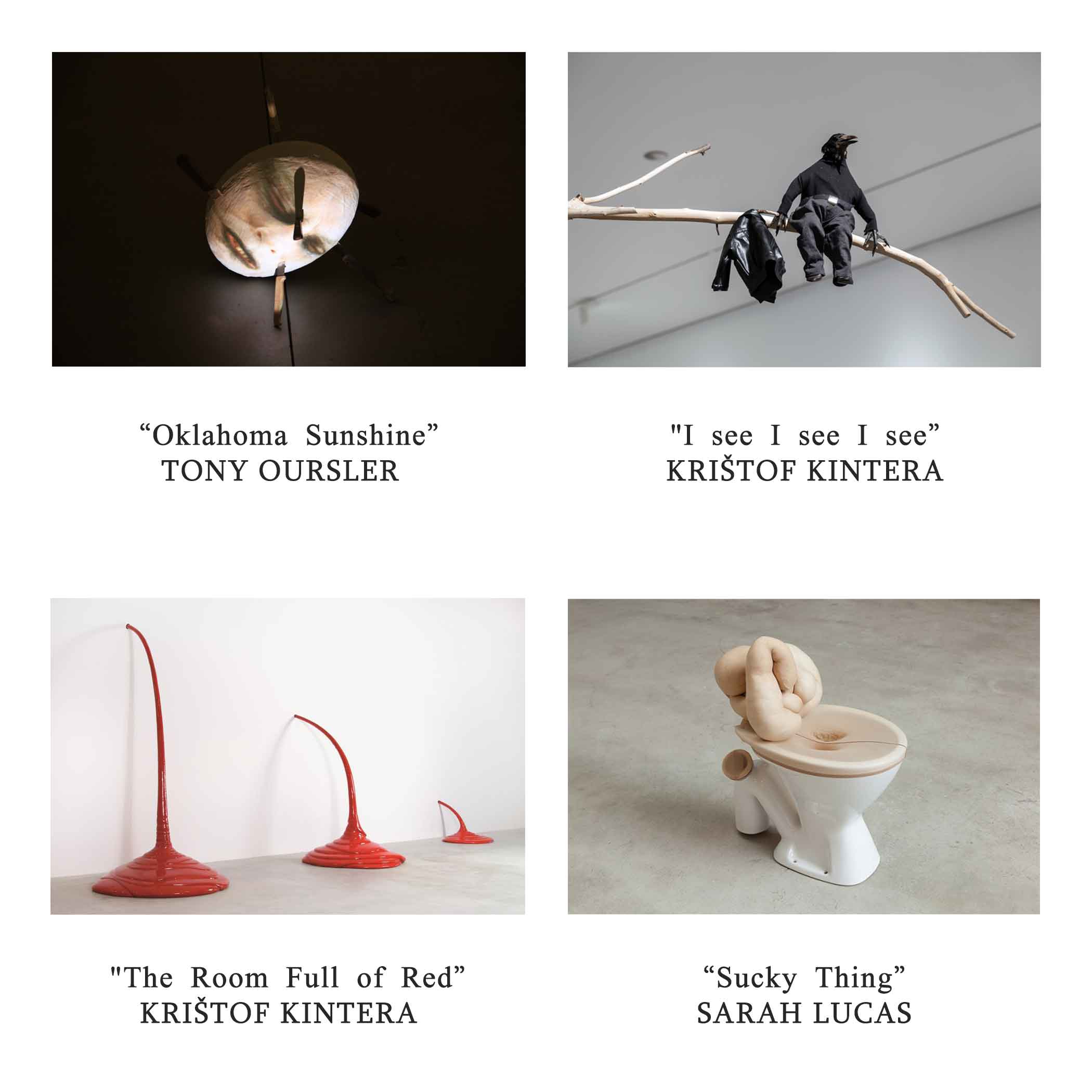When I visited Museum of Contemporary Art in Krakow (MOCAK)in 2016 I saw many works which were far from secular convivality and worldliness and as Alain Badiou said they were fraught with body, ending, death, suffering, cruelty and sexuality. In museum observer’s senses are tested with motionless sculpture on the floor similar to a skull. On the sculpture, one can see the moving face of the artist with many knives stabbed on it; the raven screaming to the observer from the corner of the wall, with the words “I can see, I can see “saying that he is following you; the “red”(directed to the people who protected soviet regime)which restricts people’s freedom and comes to life from any hole and pore; amorphous figures reminding personal parts and other works like this.
This kind of works made us think that interests about beautiful have ceded their place to sufferings, cruelty and corporeality. The latter is characteristic not only to MOCAK but also to many other museums and exhibitions[i].The observation of this kinds of works in Armenia also proves this fact. Here a question arises-Why does contemporary art stop on corporeality and ending while “stately searching endlessness”.
It is worth mentioning that explorations of corporeality is characteristic to not only contemporary art. But, unlike contemporary art romantism, which was based on sense and corporeality, meant to show human’s majesty, heroic character, freedom of soul, the inside struggles of it and to flatter philanthropist ideas. Similar expression with other manifestation existed also in expressionism which spoiled, aggravated and deformated figures to convey some emotional stress as an answer to violation, world wars and genocides of the era. Realism and hyper realism represent reality which was not shown before and which shocked the observer. But when generalizing, we should mention that unlike contemporary art, along with representing sense, suffering, violence and cruelty of daily routine all these styles also considered important aesthetics and eye-catching of the observer according to their standards.
In the 20th century beauty, art and ethics were connected. And postmodern art tried to break these links by killing beauty and resisting accepted social values. Besides, because of mass spread and consumption of beauty a human does not have need to new beauty, and this entails to its alternative. Nowadays, beauty is identified with commercion: what is beautiful, it is sellable. But contemporary art tries to oppose this state of art work. With this, art stops being seen as skill.
Since the 20th century (especially after dadaism arised) it seems irrelevant to use beautiful and aesthetics while speaking about art. That term nearly disappeared from art. Usually aesthetics is linked with ideas of harmony, orderliness and organic unity. And conciliation of antagonisms, positivity and negativity is important for it. But for some people aesthetics is an aspect of optimism, which doesn’t know anything about tragic experience. For others aesthetics is connected with positive emotions, which leaves out the negative. And the impossibility of the conciliation of these differences created unaesthetics.
While expressing the term unaesthetics Hal Foster meant a practice which denied dominance of aesthetics. Unaesthetic art has manifested itself in postmodern art, its presence is especially seen in after human, camp[ii] and abjection[iii] art. This kind of works are unaesthetic, absurd, unpleasant, sometimes disgusting and uncomfortable for people, like plastic, frozen, glazed excrements, rubbish junk, corpses, cutted body parts, bloody sculptures, peaces of meat, hibrids of technique and people, bodies with sex change, exhibitions of surgical interventions.
According to Baudrillard this is the end of art, presence of art after its death. The readoptation and restoration of past includes irony and mockery. Its aim is to disappoint spectator with mocking and disowning art and its history. Its aim is also to show art work’s meaninglessness by creating indifference to the observer, as living in the world full of commercials we witness the fact that all the goods want to be advertised and in contrast, the art shows its nothingness.
Today, art is conceptual-based on ideas: idea is fetishised, that is not the main value but its abstract notion. If Eve Clen, who sells air, sells idea in show-room then contemporary art is the absence of that idea, the emptiness. From this point of view Baudrillard thinks that art is disappearing.
Accepting the fact that each work of the above mentioned styles of contemporary arts is directed to the solution of this or that problem[iv],however we can bring some reasons why some contemporary artists show or create reality without sympathy to the observer or its hero leaving out the part of aesthetics as well.
Bibliography
- Բադյու, Ա․ (2011). Տասնհինգ թեզիս ժամանակակից արվեստի մասին, http://www.arteria.am/hy/1319800203
- Բոդրիյար, Ժ. (1998). Գեղագիտական պատրանք, հիասթափություն,
- Սողոմոնյան, Գ., Ժամանակակից մարդաբանական ճգնաժամի դրսևորման առանձնահատկությունները, էջ 18-33, http://ysu.am/files/02G_Soghomonyan-1461230359-.pdf
- Քոչինյան, Ա․ (2016). Կամք, արվեստ և վերագործարկում
- Бодрийяр, Ж. (1996). Заговор искусства, http://lit.lib.ru/k/kachalow_a/complot_de_lart.shtml
- Выготский, Л. С. (1998). Психология искусства, https://www.marxists.org/russkij/vygotsky/art/psichologia-iskusstva.pdf
- Millner, J. (2013). Essay: Beauty Disparaged, https://contemporaryartandfeminism.com/2013/10/22/essay-beauty-disparaged/
Author: Marine Khachatryan. ©All rights are reserved
Translator: Edita Shadoyan
